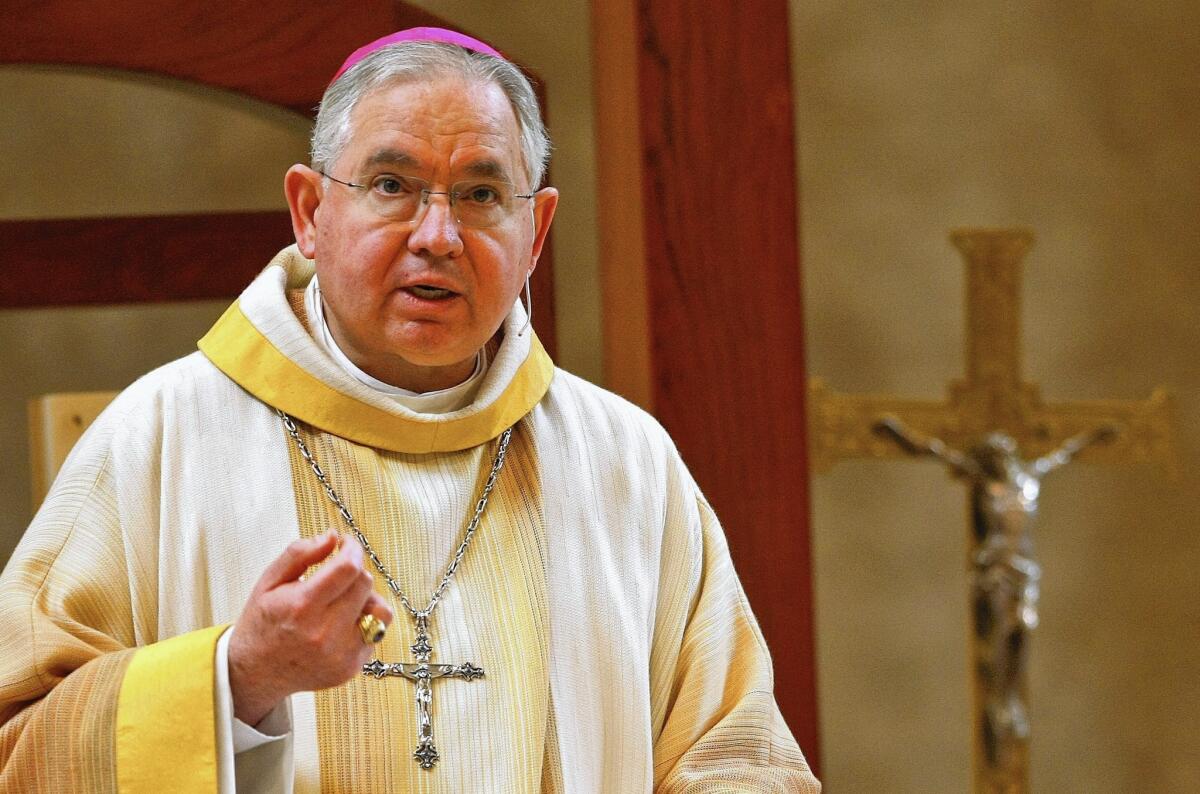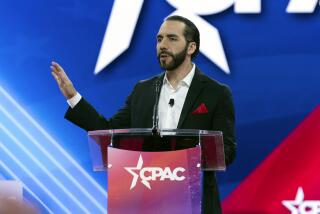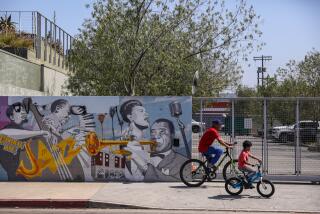L.A. Archbishop Gomez, a tenacious advocate for immigrants, becomes first Latino to lead U.S. bishops

On the eve of his election as the new leader of U.S. bishops, Archbishop José Gomez had a message for the faithful back home: It was well past time for immigration reform.
“In this great country, we should not have our young people living under the threat of deportation, their lives dependent on the outcome of a court case,” the archbishop of Los Angeles said in an email to his flock Monday evening.
Alluding to Tuesday’s U.S. Supreme Court arguments on the Deferred Action for Childhood Arrivals program, Gomez continued: “We pray tonight that our president and Congress will come together, set aside their differences, and provide our young brothers and sisters with a path to legalization and citizenship.”
Already the highest-ranking Latino in the U.S. Catholic Church, Gomez on Tuesday marked another milestone when he became the first Latino elected president of the U.S. Conference of Catholic Bishops.
Born in Monterrey, Mexico, Gomez has in recent years evolved into a high-profile and authoritative voice in the American church, advocating for policy reforms that would include a path to citizenship for immigrants living in the country illegally. The soft-spoken 67-year-old will begin his three-year term as president just as his tenure as vice president comes to an end.
His election, which kicked off the second day of the bishops’ fall meeting in Baltimore, was regarded by many observers of the Roman Catholic Church as a fait accompli, a historic moment set in motion in 2016 when he was elected vice president of the national conference. Some within the church hope that Gomez will utilize his experience fighting for immigrant rights in his new post, leading the conference to be more outspoken in advocating for immigration reform.
“I am overwhelmed. It is a big responsibility,” Gomez said in a phone interview Tuesday. “I am grateful to the bishops for their support and confidence in me, and I think this is a great lesson for the archdiocese, for Los Angeles and Latinos in the country.”
Gomez’s rise comes amid Latinos’ shifting relationship with the Catholic faith. U.S. Latinos are no longer majority Catholic, according to a Pew Research Center survey released last month. Some 47% describe themselves as Catholic, the survey showed, down from 57% a decade ago. At the same time, 23% of Latinos say they are religiously unaffiliated, up from 15% in 2009.
Gomez’s ascendance could help shore up or even replenish the number of Latino Catholics.
“This is huge,” Father Thomas J. Reese, a senior analyst at Religion News Service, said of the election. “Having a Mexican American as the president of the bishops conference sends a real message to Hispanics across the country, showing that not only are they part of the church, they are also part of the leadership of the church at the highest level.”
Gomez, a naturalized U.S. citizen, will take up his new position at a time of bitter division over the Trump administration’s immigration policies, Reese added.
“This is a Mexican immigrant who is going to be the leader at a time when immigrants are demonized,” Reese said. “This is a symbolic message from the bishops on the importance of the immigration issue to them, and the importance of immigrants to the Catholic Church and in American society.”
L.A.’s archbishop is at once a conservative and a progressive: staunch in his opposition to abortion and same-sex marriage while tenacious in his advocacy for immigrants and the poor.
“He knows we have a very divided church today, and one of my hopes with him as the head of the conference is he will find ways to bring us together,” said Father Thomas P. Rausch, a professor of theological studies at Loyola Marymount University. “He’s conservative, but his impulses are pastoral.”
As the archbishop of the San Antonio Archdiocese before coming to L.A., Gomez emerged as a leading advocate for doctrinal conformity, determined to stave off what he saw as creeping secularism in the church.
But in 2013, Gomez published a book that voiced his support for a path to citizenship for the estimated 11 million immigrants living in the country without legal status. His advocacy aligns with efforts by Pope Francis to raise awareness about the challenges immigrants face.
When a gunman targeting Mexicans killed 22 people at a Walmart in El Paso in August, Gomez took a public stand against white supremacy. “A line has been crossed in our nation,” he wrote.
In September, Gomez led the Mass in Recognition of All Immigrants, during which he told his congregants that “this nation has been a beacon of hope, a refuge for peoples who have no place left to turn.” And on Monday night, his archdiocese hosted a rosary and Mass in solidarity with so-called Dreamers, praying for them before the Supreme Court hearing.
American bishops oppose “enforcement only” policies and support comprehensive immigration reform, a stance that stems from their belief that migration is a humanitarian issue rather than a politically partisan one.
Gomez said he never expected that one day he would be the man to lead the conference, despite his decades-long career in the church.
In 1978, he was ordained a priest of the Opus Dei prelature by the late Cardinal Franz Konig at the Shrine of Torreciudad in Spain. Years later, he would serve as an auxiliary bishop of the Archdiocese of Denver before being appointed archbishop of San Antonio. He became the first Latino archbishop of Los Angeles when he succeeded Cardinal Roger Mahony in 2011.
“I just wanted to be a priest,” Gomez said with a laugh. “That’s what I felt that God was asking me to do.”
Gomez has called immigration the “reality of my own family,” his ardor for the cause culminating in passionate sermons, visits with migrant children separated from their parents at the border and fervent columns. He has assembled an immigration task force that includes representatives from the dioceses of L.A., Orange and San Bernardino.
Immigrants today are the main force preventing a sharp decline in U.S. Catholic Church membership, which some estimates put at about 70 million.
“Basically the bishops are handing him a megaphone that he can use on issues like DACA, family separations and other issues that affect immigrants,” Reese said.
Catholics, like the general U.S. population, are divided over immigration, notably along ethnic lines. About 77% of Latino Catholics favor allowing immigrants who are living in the U.S. illegally an opportunity to become citizens, compared with 55% of white Catholics, according to the Public Religion Research Institute.
Gomez has said that those who are here illegally must be held accountable by paying fines — and perhaps performing community service — and they must educate themselves about the country’s laws and government. Deportation, he believes, is a punishment that doesn’t fit the crime.
“It’s important for the church to pray for [reform]. We did last night in Los Angeles,” he said. “And it’s important to educate people on what their rights are, and how they can actively participate in making a difference.”
Gomez said he hopes Latinos see his election as a “sign that the United States is aware of the presence and importance of the Latino community in our country.”
Hosffman Ospino, associate professor of Hispanic ministry and religious education at Boston College, said Gomez’s election could open the gates to more Latino leadership within the church at a time when there are “very few Hispanic bishops in the United States and very few archbishops.”
“We are beginning to see a national transition from mostly Irish, Italian, German American Catholicism to one that is mostly Latino, and also Asian,” he said. “The diversity that we see in the parish is not always reflected in the hierarchy in positions of leadership. José Gomez in many ways symbolizes of what is already taking place at grassroots level.”
As a boy, Gomez regularly traveled across the border, moving between his home in Monterrey and his uncle’s house in San Antonio. He would go fishing with his father at South Padre Island, using his passport and la mica, a border-crossing card needed to make the journey at the time.
Parts of his family have lived in Texas since 1805, he said, when the area was still under Spanish rule. His grandparents were married at the cathedral in San Antonio in 1917.
“This is a major milestone, not simply because of where Archbishop Gomez comes from, but who he is,” said John Carr, director of the Initiative on Catholic Social Thought and Public Life at Georgetown University. “In a wounded church, he can be a healer. In a divided nation, he is a bridge builder.”
Carr, who served as an advisor to the U.S. bishops on public policy for two decades, said he sees Gomez as “a pastor and teacher, not a culture warrior.”
“He defends the lives of unborn children and the dignity of undocumented immigrants because they are all children of God, not to advance a political or ideological agenda,” he said.
More to Read
Start your day right
Sign up for Essential California for news, features and recommendations from the L.A. Times and beyond in your inbox six days a week.
You may occasionally receive promotional content from the Los Angeles Times.







